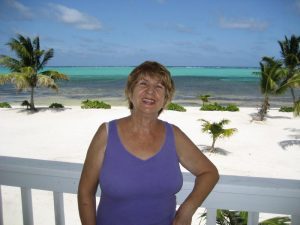In a small community like Belize, one makes friends with a wide assortment of people of differing backgrounds. Names and faces spin past as I write, reminding me of the friendliness that has been one of Belize’s greatest gifts.
![[Tom]](https://www.tcracs.org/kvswp/wp-content/uploads/TomT66-15ed-154x300.jpg)
The Tattersfields, Lia and Tom, lived next door to us. We had met them soon after we arrived in Belize in the mid Fifties, but did not become close friends until we moved into the house on the Southern Foreshore in 1960. Tom was a tall man with a quirky sense of humor. Formerly a major in the British Army, he never lost his officer’s bearing and demeanor. At the time we met, he was the country’s only Chartered Professional Accountant (C.P.A.).
![[Lia]](https://www.tcracs.org/kvswp/wp-content/uploads/Lia66-12ed-203x300.jpg)
Lia was a beautiful blond Latvian—enthusiastic, endearing, and glamorous. She and her parents had fled Latvia on thirty-minutes’ notice one Sunday during World War II, escaping just ahead of the Russian Army’s advance. They made their long, painful way through Poland to Germany where they ended in a camp for Latvian refugees in Hamburg. Tom was the Officer-In-Charge of the camp. Lia, in her late teens, spoke good English and became interpreter for the Latvian internees.
The Tattersfield children and ours became inseparable when we were neighbors. Studious Tony was a bit older than Alex, and Sandra, called Sissy, was between Alex and Carli. Tiny Debbie, at age almost 3, was soon everyone’s pet.
When Lia and Tom went to England on holiday, they left the children in the charge of the devoted and capable Ella, who had taken care of the family for years. During their parents’ absence, the Tattersfield children were in our house more often than in their own. Little Debbie, confused at hearing half her playmates call Bucher Daddy and the other half call him Mr. Scott, solved the problem to her own satisfaction and Bucher’s delight by dubbing him Mister-Scott-Daddy.
![[Sis, Deb, Carli]](https://www.tcracs.org/kvswp/wp-content/uploads/CSisDeb66-300x300.jpg)
The Tattersfields and Scotts spent increasing amounts of time together. The “T-fields” invited us to spend the odd weekend with them at their house on St. George’s Caye. We invited all of them for boating holidays.
Lia insisted that we join them each year for her big family Christmas Eve dinner. Active games, which included the children as well as the adults, enlivened the evenings. One year when Belize was shivering under an unaccustomed Norther, Bucher was on what he was sure was his death bed with what he called pneumonia and what I considered a hard cold. Lia insisted that he come anyway. Tom met us at the door with something he introduced with a flourish as a “Boston Bracer.” The hot concoction of brandy (so as not to clash with Christmas dinner wines) and beaten egg whites turned my ailing husband into the life of the party.
Another life-long friendship that began when we moved into the house on the Southern Foreshore was with Juanita Pérez and her family, who lived below us in the first floor flat.
The Pérez family was from northern Spain. Tuto Alamilla, who was courting Juanita, had grown up on Ambergris Caye, British Honduras’s northernmost island. His family came originally from Mexico.
Juanita, just out of her teens, was a shrewd businesswoman, voluble, excitable, and entrancing. Tuto, a successful shipping agent, was a quiet, amused foil for Juanita’s explosions.

We had the fun of watching their courtship grow to marriage and of taking part in their wedding festivities. A year later we were drafted to help with preparations to welcome their first child, Aleda, when Juanita brought her home from the hospital.
The hospital released Juanita unexpectedly on a Saturday morning. Juanita’s mother, Sra. Perez, whom we privately called The Señora, came up upstairs to consult to us in a panic because they did not yet have all the baby supplies they needed. Bucher and I dashed downstairs with her, made our own rapid inventory, which was somewhat more comprehensible than her excited Spanish, and compiled a shopping list. I sent Bucher off to buy bottles, nipples, a sterilizer, baby powder, lotion, oil, cotton, and a few other things.
I remained with The Señora to set up a nursery area in Juanita and Tuto’s bedroom. Fortunately, the crib was ready, and they already had sheets for it. Bucher returned, breathless, to deliver his purchases, and then fled to the quiet of our flat upstairs. I threw myself into my work with all the enthusiasm of a former new mother about to become a proxy aunt. The Señora, half-undone by the imminent arrival of her first grandchild, brought out her store of family photographs and tried to show them to me as I raced the clock.
By the time a beaming Tuto gently led his happy wife, cradling their infant daughter in her arms, into their home, all was ready for them. I cooed briefly, then left to let them enjoy the homecoming together.
![[Emilie]](https://www.tcracs.org/kvswp/wp-content/uploads/Emilie-19-175x300.jpg)
When we moved into the Foreshore neighborhood, we began to know Emilie and Eric Bowen better. They lived a couple of blocks north of us, just to our side of the curve that takes the Foreshore past the Supreme Court building. Emilie’s and my friendship grew even closer in later years.
![[Eric]](https://www.tcracs.org/kvswp/wp-content/uploads/Eric1980-236x300.jpg)
Eric was from an old Belize family and had established himself as one of the country’s leading importers. Emilie’s family was French. She was born in British Honduras but grew up in California. Emilie returned in her late teens and she and Eric married somewhat younger than their parents might have wished. They had four exceptionally handsome children, two boys and two girls, all slightly older than our two. The youngest son, Bruce, became a close friend of our Alex.
They were an attractive couple, Eric poised and gallant in an old-fashioned way, and Emilie, vivacious, charming, irrepressible.
![[typist]](https://www.tcracs.org/kvswp/wp-content/uploads/typist4.png)